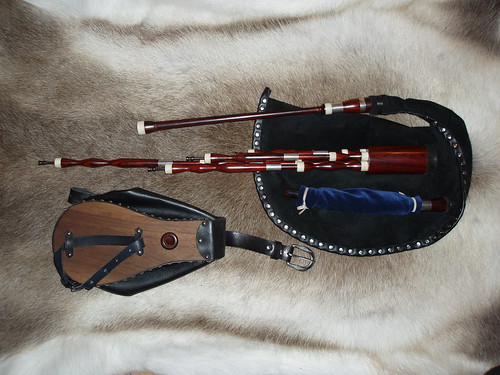|
-
24th March 14, 08:42 PM
#1
How to start learning the Scottish Small Pipes
Hi, all! I would like to learn to play the Scottish small pipes. Should I start out by getting a highland pipes practice chanter or is there some other kind of chanter that I should get instead? I have been trying to research this online but as a complete newbie I am finding it hard to understand where to start. Thanks for your help!
-
-
25th March 14, 02:43 AM
#2
Hi,
A highland pipes practise chanter will serve you perfectly well. The chanter on the SSP differs very little from a practise chanter. Both are straight bore and have very similar finger spacings.
There are two major differences between playing SSP and GHB (Great Highland Bagpipes) and those are the bellows (should you choose a bellows set), and playing style.
Bellows SSP are in my opinion by far the best. Probably the simplest way of practising the bellows is just to wait until you purchase your actual SSP and practise blowing a steady low 'A' over and over, resisting the temptation to burst into a tune. Do this lots, for a looooong time.
As for playing style, it's perfectly possible to play tunes in GHB style, but SSP are associated* with the lowland and borders piping tradition, which uses simpler grace notation.
I recommend "The Master Piper - Nine Notes That Shook The World"
http://www.bagpipesociety.org.uk/the...ook-the-world/
and the Lowland and Borders Piping Society (LBPS)
http://lbps.net/lbps/index.php
Here's my SSP, made by E.J. Jones in Texas.

*The Scottish Smallpipes in their modern form are actually a recent invention, created in the 1980s but based on earlier examples dating back several centuries.
-
The Following User Says 'Aye' to Calgacus For This Useful Post:
-
25th March 14, 08:24 AM
#3
The fingering of the Scottish smallpipes is identical to that of the Great Highland Pipes, so a regular practice chanter is the appropriate practice instrument. You can find lots more info and ask all your questions about the Scottish smallpipes on the Bob Dunsire forums. There is a forum specifically for Uilleann, Northumbrian and Smallpipes.
http://forums.bobdunsire.com/forums/index.php
-
-
25th March 14, 07:16 PM
#4
Yes what they said!
A practice chanter is actually far closer to an SSP chanter than it is to a GHB chanter.
The PC and SSP chanter both have a narrow straight/cylindrical bore. Both are far more forgiving of 'false fingerings' than the GHB chanter.
When I switch from GHB to SSP everything seems so easy! Everything sounds cleaner. You can pretty much finger notes any way you want and they sound the same. It's the GHB chanter's very instability that allows certain extra notes to be played such as C natural, F natural, and high G sharp. An SSP chanter is so stable that opening and closing holes beneath the one producing the note cause little change.
If you spend some years playing SSP exclusively you will probably find if you take up the GHB that numerous 'wooly' bits will be present in your fingering that will take quite a bit of practice to get rid of.
For newbies it's hard to beat the John Walsh "Smallpipes in A 2000" because of their reliability and ease of play. You can spend all your time playing rather than mucking with the reeds.
Here they are
http://www.johnwalshbagpipes.com/car...ge=small_pipes
Here's what I play, an approximately 100 year old set of 'miniature Highland pipes' as the 19th century makers called them (the term "Scottish Smallpipes" appears to be modern, borrowed from the Northumbrian Smallpipes).
They're on the right, cocus and real ivory, with the original cow-horn mouthpiece. Ebay $200. I had John Walsh make me a chanter in A for that set. The set sounds great, with fantastic warm drones and a very nice chanter.
Also in that photo is, at left, an African Blackwood fullsize set by Dunbar, and at centre a 100 year old Glen set, ebony and real ivory, around 7/8 size, what the 19th century makers called "halfsize or reel pipes" and what we call "three-quarter size pipes" today. As you can see they are neither half size nor three quarter size.) The Glen set has an ebony "Lowland" chanter in A by Jon Swayne with a high B key.

Here is a closeup of my miniature set

I find SSPs in A comfortable to play. The finger-spacing on my John Walsh A SSP chanter is nearly identical to the spacing on a modern 'fullsize' practice chanter, or a GHB chanter.
I find SSPs in D difficult to play because the fingerholes are rather close together.
Probably SSP chanters in Bb or C would have a more or less ideal spacing.
The A SSP chanter is nice because all the pipes tunes come out in the keys that they're written in, the keys that fiddlers and accordion players play them in.
Last edited by OC Richard; 25th March 14 at 07:42 PM.
Proud Mountaineer from the Highlands of West Virginia; son of the Revolution and Civil War; first Europeans on the Guyandotte
-
-
27th March 14, 03:00 PM
#5
I thank you all for your excellent advice! 
-
 Posting Permissions
Posting Permissions
- You may not post new threads
- You may not post replies
- You may not post attachments
- You may not edit your posts
-
Forum Rules
|
|




















Bookmarks